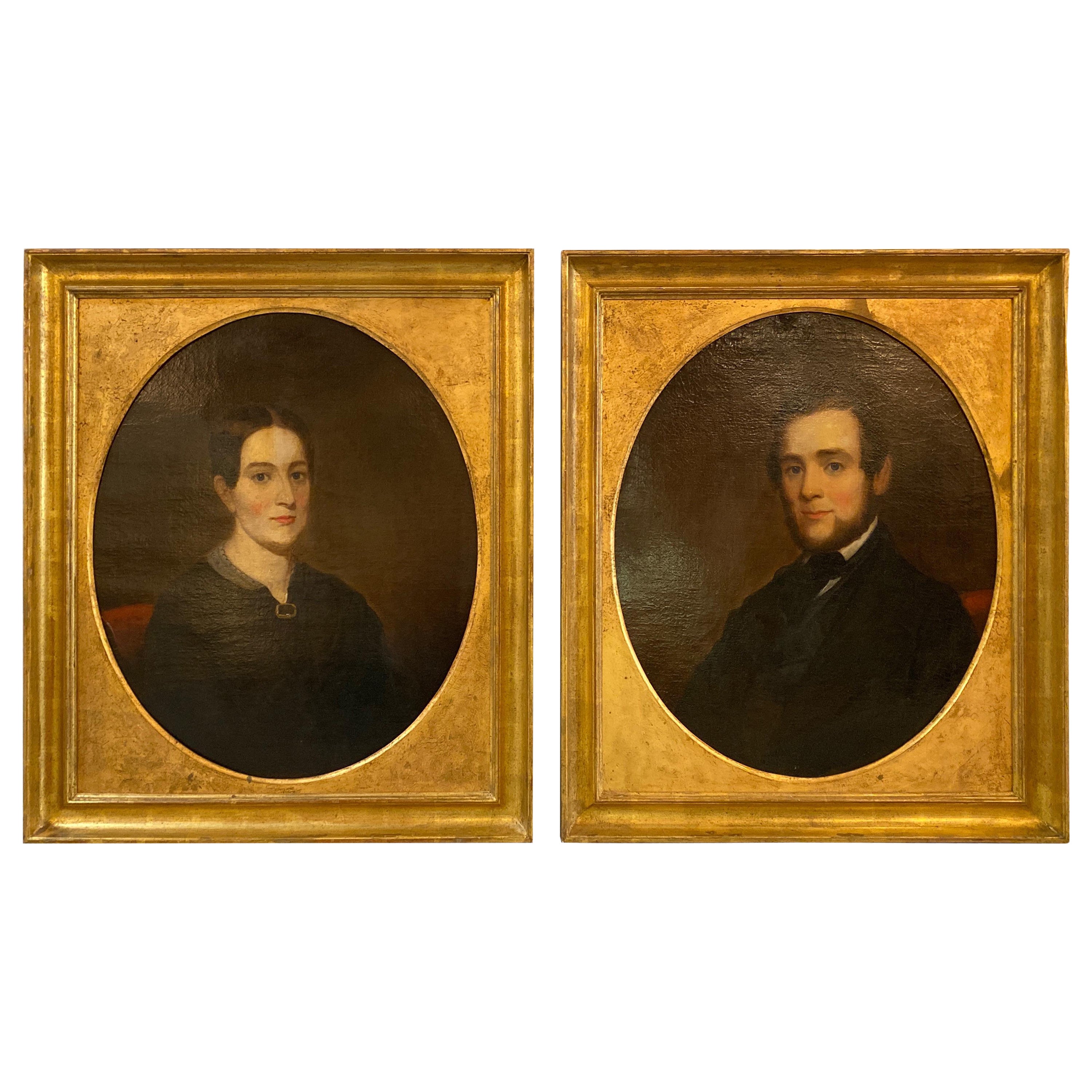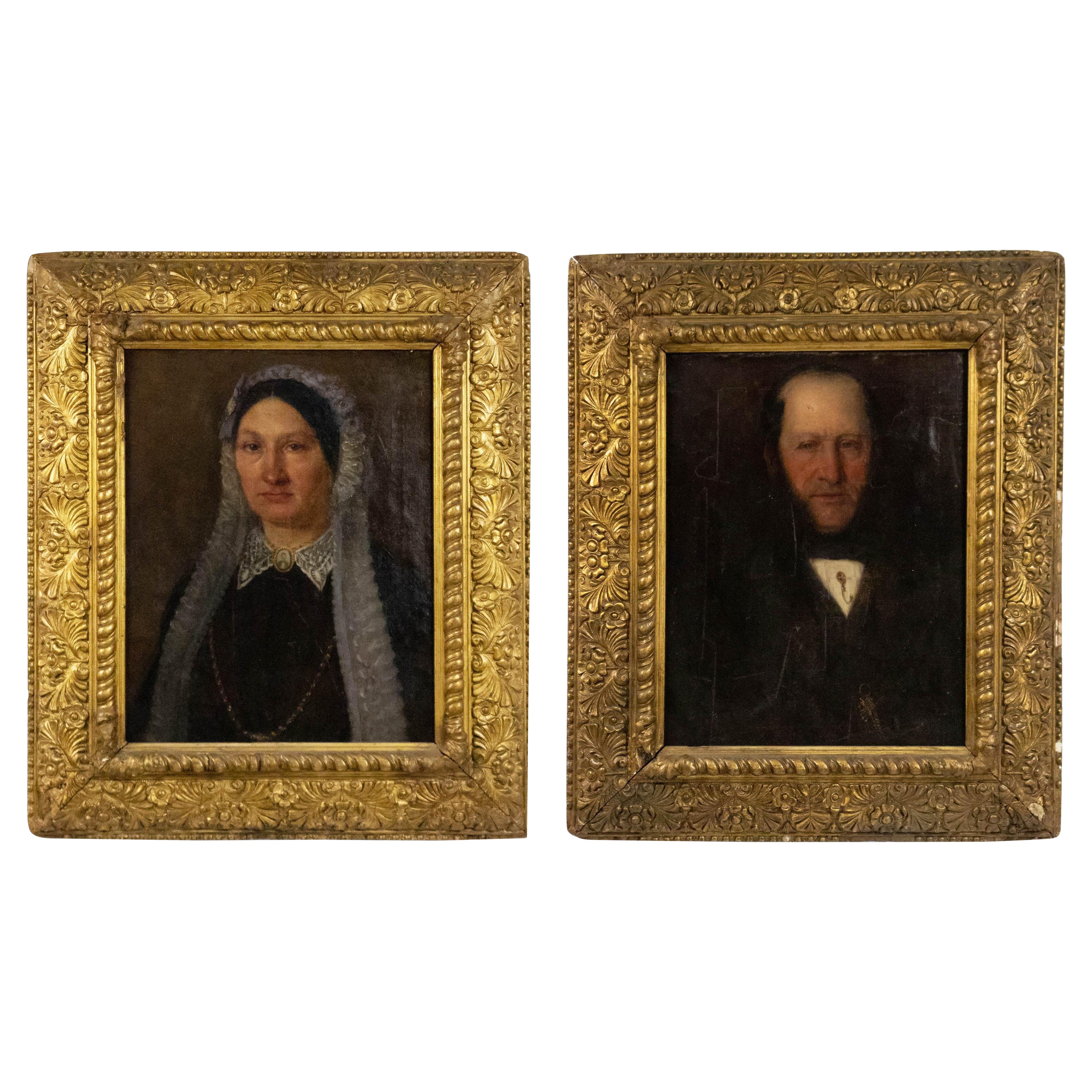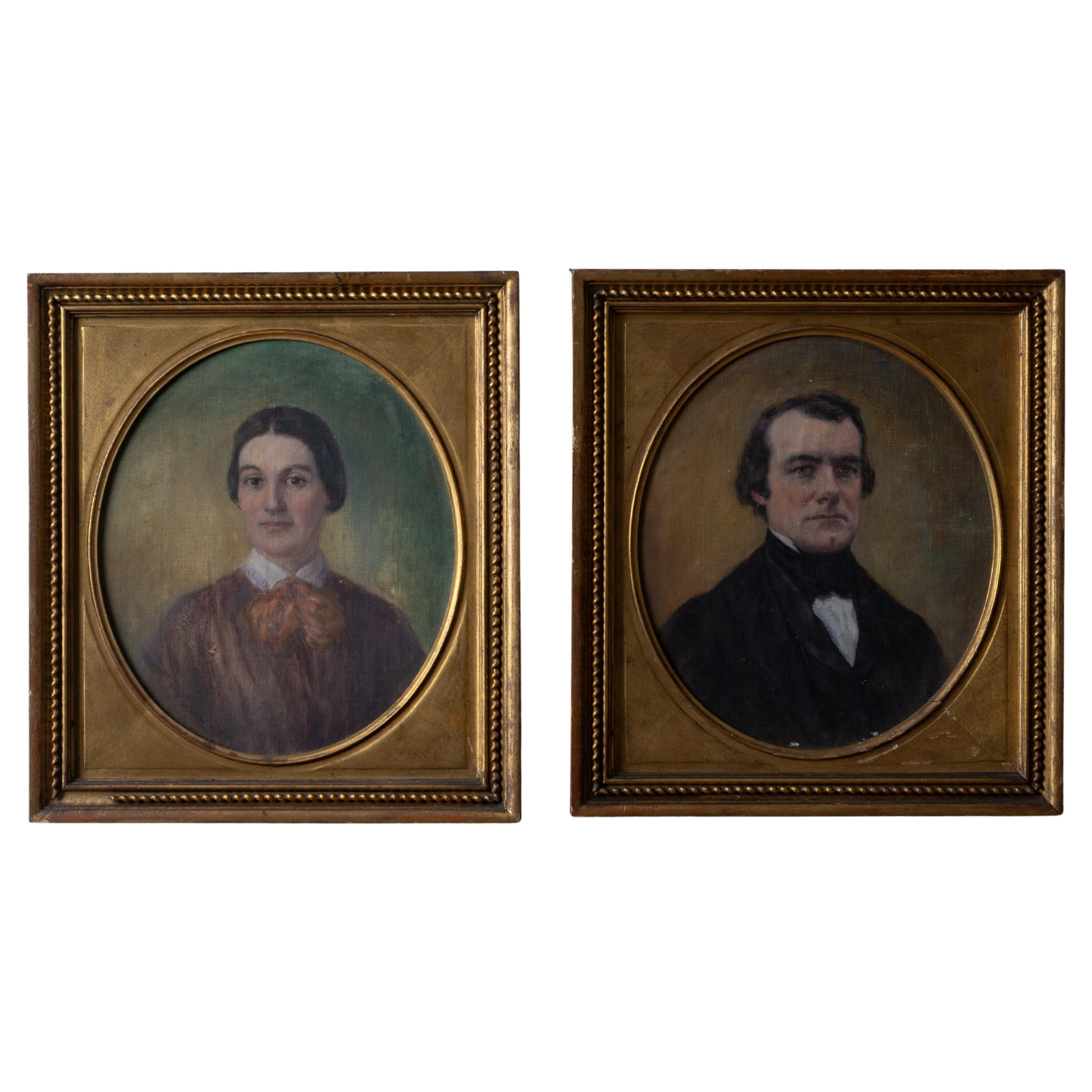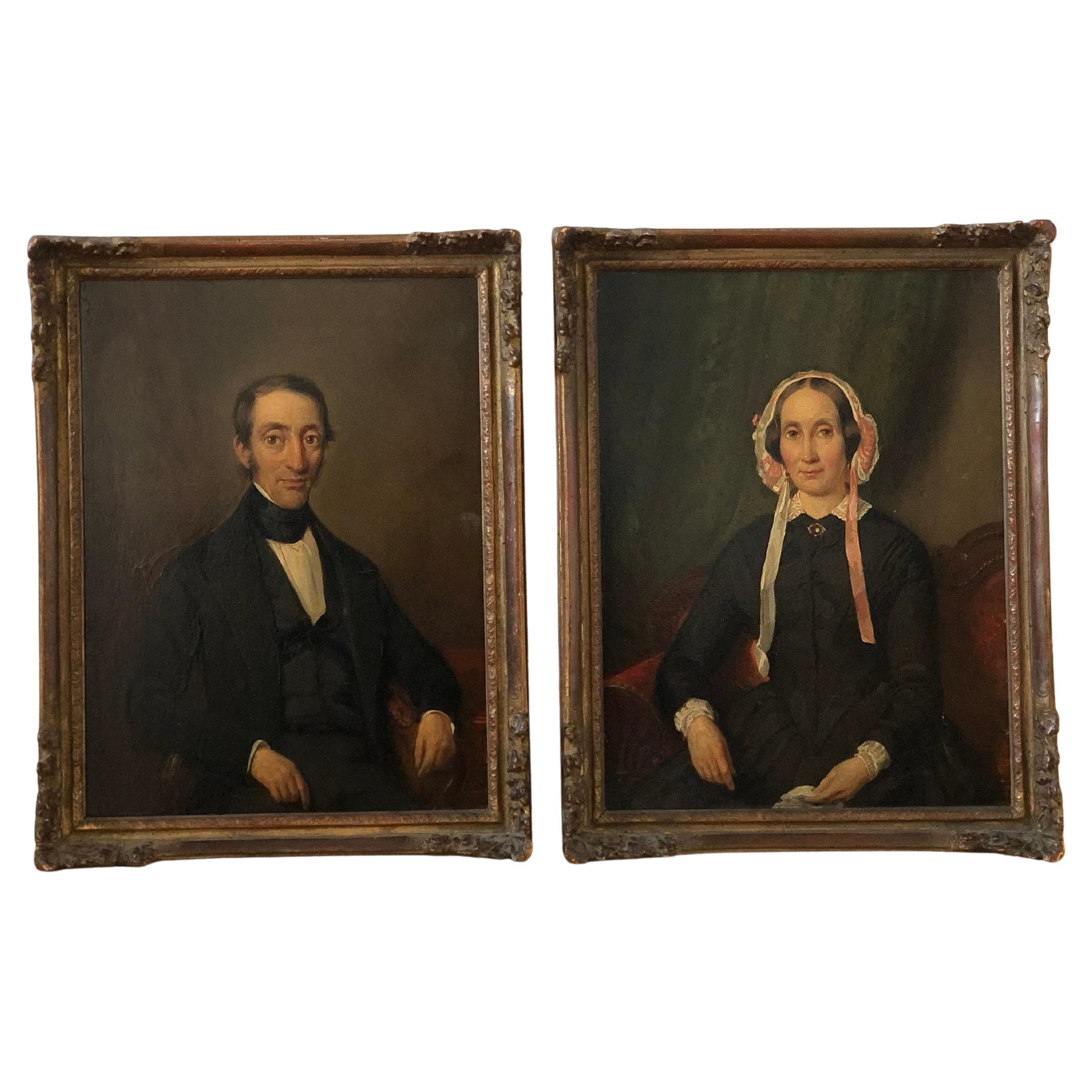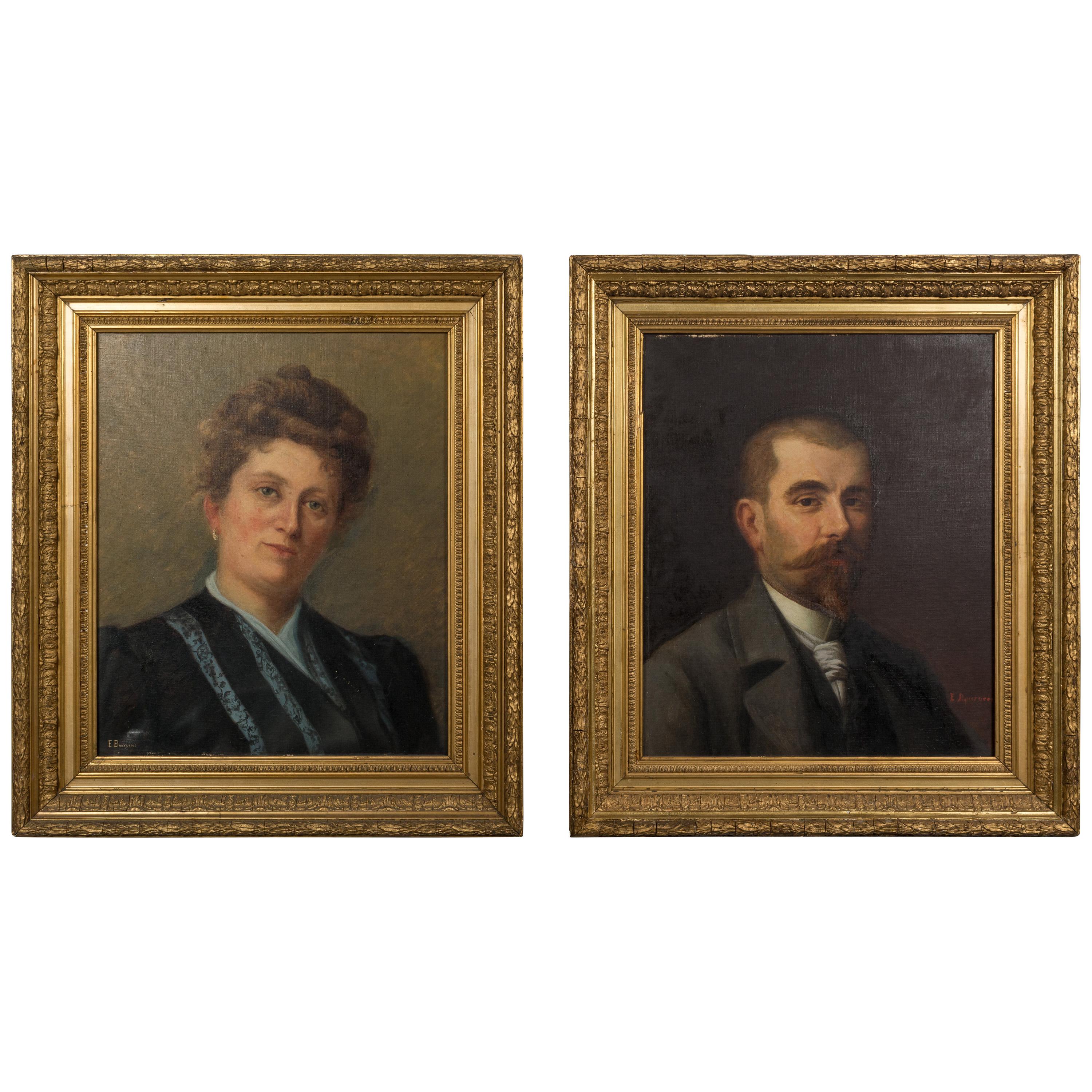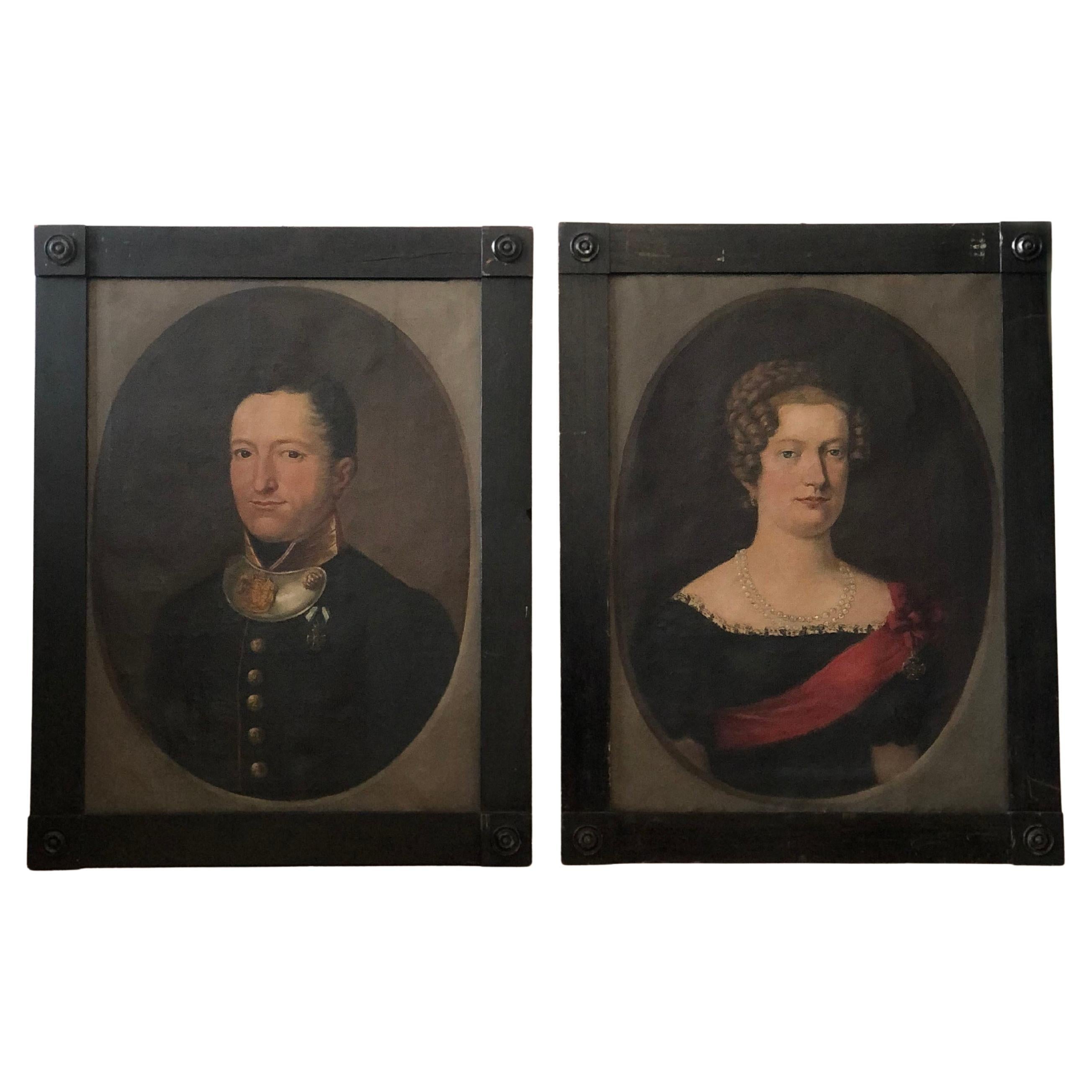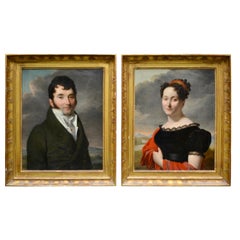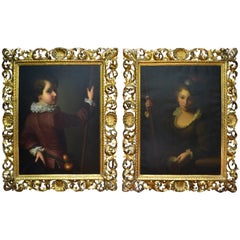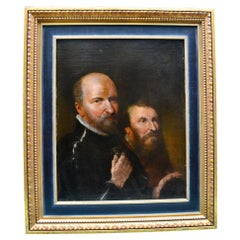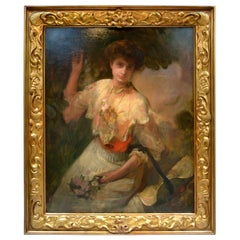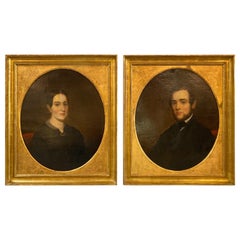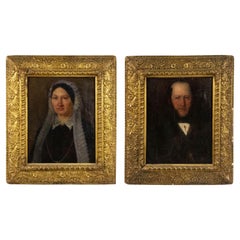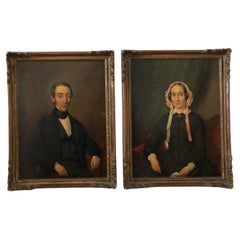Items Similar to Pair of Victorian English Portraits Mounted on Panel
Video Loading
Want more images or videos?
Request additional images or videos from the seller
1 of 22
Pair of Victorian English Portraits Mounted on Panel
$6,000per set
£4,557.49per set
€5,251.77per set
CA$8,449.49per set
A$9,367.50per set
CHF 4,922.99per set
MX$114,642.89per set
NOK 61,483.13per set
SEK 57,708.07per set
DKK 39,201.23per set
About the Item
Pair of beautifully painted oil portraits of a mid-Victorian English couple. Portrayed from the chest up, the lady looks directly at the painter, showing an elaborate hair style woven with bunches of flowers on each side and held in place with silk ribbons around her neck. The rather stern looking husband is formally dressed, facing to his left and is shown with his dark groomed moustache and beard below a receding hairline. Both portraits are displayed in gold carved wood frames. They are unsigned.
- Dimensions:Height: 23 in (58.42 cm)Width: 19.5 in (49.53 cm)Depth: 2.5 in (6.35 cm)
- Sold As:Set of 2
- Style:High Victorian (Of the Period)
- Materials and Techniques:
- Place of Origin:
- Period:
- Date of Manufacture:circa 1875
- Condition:Refinished. Wear consistent with age and use. Minor losses. Both paintings and frames were cleaned. Board alone 15"H x14.25" W.
- Seller Location:Vancouver, CA
- Reference Number:1stDibs: LU4631228655222
About the Seller
4.9
Vetted Professional Seller
Every seller passes strict standards for authenticity and reliability
Established in 1981
1stDibs seller since 2019
163 sales on 1stDibs
Typical response time: 1 hour
- ShippingRetrieving quote...Shipping from: Vancouver, Canada
- Return Policy
Authenticity Guarantee
In the unlikely event there’s an issue with an item’s authenticity, contact us within 1 year for a full refund. DetailsMoney-Back Guarantee
If your item is not as described, is damaged in transit, or does not arrive, contact us within 7 days for a full refund. Details24-Hour Cancellation
You have a 24-hour grace period in which to reconsider your purchase, with no questions asked.Vetted Professional Sellers
Our world-class sellers must adhere to strict standards for service and quality, maintaining the integrity of our listings.Price-Match Guarantee
If you find that a seller listed the same item for a lower price elsewhere, we’ll match it.Trusted Global Delivery
Our best-in-class carrier network provides specialized shipping options worldwide, including custom delivery.More From This Seller
View AllPair of French Empire Portraits of an Aristocratic Couple by Antoine Borel
Located in Vancouver, British Columbia
A pair of original oil paintings on canvas depicting a handsome young aristocratic couple of the Directoire, early Empire period. They are each pictured from the waist up, she holdin...
Category
Early 20th Century French Empire Paintings
Materials
Canvas
Pair of Paintings Depicting Pilgrims of Compostela After Grimou
Located in Vancouver, British Columbia
A complementary pair of 19th century Italian paintings in the "chiaro scuro" style depicting pilgrims gazing intently with a certain degree of sentimental...
Category
Antique Mid-19th Century Italian Baroque Paintings
Materials
Canvas
$8,000 Sale Price / set
33% Off
18th Century English Portrait of Two Bearded Gentlemen
Located in Vancouver, British Columbia
An unsigned canvas depicting two bearded ‘Renaissance’ gentlemen painted from the waist up in a loving posterior embrace. The painting is very likely English late 17th or 18th century. Relined well over a hundred years ago which suggests that the work may be 17th or 18 century. Presently in a contemporary, compatible frame.
The canvas relining was done by John Peel who was active in London in the early 19thC. John Peel worked from Golden Square, London 1819, 7 Naylors Yard 1820-1834, 17 Golden Square 1832-1843, 17-18 Golden Square 1844-1858, 12 Marlborough Row as carver and gilder...
Category
Antique Mid-18th Century English Renaissance Revival Paintings
Materials
Canvas
Signed Portrait of an Aristocratic Lady by English Victorian Artist Laurence Koe
By Laurence Koe
Located in Vancouver, British Columbia
A large and beautiful three quarter length portrait of a partly seated lady her hat over one arm holding a bouquet of flowers, the other arm held upward holding a branch of a tree. This original oil on canvas by the British artist Laurence Koe, (1863-1913), is signed on the lower right and dated 1905.
Lawrence E. Koe was a portrait painter and sculptor. He is listed as living in Brighton when he first exhibited at The Royal Academy in 1891, but by 1894 he had moved to London where he appears to have settled for the remainder of his life. Koe exhibited widely; over twenty times at The Royal Academy, but also at the R.O.I, The Royal Society of Artists in Birmingham and the Walker Art Gallery in Liverpool. Most of his exhibited works were portraits, and among his sitters were the wives of fellow artists Harold Speed RP (1872-1957) and Harold Piffard (fl. 1895-1899). In 1896 Koe exhibited “Venus and Tännhauser” at the Royal Academy, now in the permanent collection in the Brighton Museum and Art and he showed a painting of Sappho two years later. He clearly shows the influence of other artists working at the same time, notably Singer Sargent, Arthur Hacker RA (1858-1919) and Herbert James Draper...
Category
Early 20th Century English High Victorian Paintings
Materials
Canvas
19 Century English Portrait of an Aristocratic Gentleman in the Manner of Rubens
By Peter Paul Rubens
Located in Vancouver, British Columbia
A 19th C three quarter length portrait of an aristocratic gentleman with his personal valet shown behind him. The young man with flowing long hair is portrayed from the waist up and ...
Category
Antique Mid-19th Century English Renaissance Paintings
Materials
Canvas
Pair of 18 Century Paintings of St Francis Xavier and St Carlo Borromeo
Located in Vancouver, British Columbia
A beautifully executed and rare complementary pair of oil on canvas paintings depicting two of the moist famous and important counter reformation catholic saints St Francis Xavier and St Carlo Borromeo shown in scenes of what the respective saints are mostly famous for. St Francis Xavier for the conversion to Christianity of many S. E Asian countries notably India and St Carlo Borromeo shown asking the Virgin Mary to intercede for the cessation of the terrible plague of 1576. The paintings are presented in refreshed gilded carved wooden frames and are unsigned.
St. Francis Xavier was born in Spanish Navarre in 1506 and in 1528, he met St. Ignatius of Loyola. He became one of the seven in 1534 who founded the Society of Jesus (Jesuit Order). In 1536, he left the University of Paris and joined St. Ignatius in Venice. He was ordained in 1537, and in 1540 after the Society was recognized by the Pope, he journeyed to the Far East. Francis Xavier first evangelized the Portuguese colony of Goa in India, then Travancore, Ceylon, Malacca, and the surrounding islands. From there he journeyed to Japan, where he gave Christianity such deep roots that it survived centuries of violent persecution. He died on Sancian Island in 1552, while he was seeking to penetrate into the great forbidden land of China.
Despite language problems, lack of funds, resistance from the Europeans as well as the natives, he persevered. St. Francis converted more people in his life than anyone since the Apostle St. Paul. He baptized over 3 million people, converted the entire town of Goa in India, and he labored in India, Pakistan, Bangladesh, Sri Lanka, Malaysia, Indonesia, Singapore, and Japan. He was truly a missionary par excellence.
St Carlo Borromeo (1538-1584), was a Cardinal of the Holy Roman Catholic Church and Archbishop of Milan from 1565 to 1583. He was described in the decree for his canonization, as “a man, even while the world smiles on him with the utmost flattery, he lives crucified to the world, spiritually, trampling earthly things, seeking continuously the things of heaven, emulating the life of the Angels on earth, in his thoughts and actions.
The plague began in the month of August that year. Milan was celebrating joyfully the arrival of Don John of Austria, on his way to Flanders, where he had been appointed governor. The city authorities were abuzz with excitement in their desire to bestow the highest honours on the Spanish prince, but Charles, who had been Archbishop of the diocese for six years, was following with concern the news coming from Trento, Verona and Mantua, where the plague had begun claiming victims. The first cases exploded in Milan on August 11th, right at the moment when Don John of Austria arrived. The victor of Lepanto, followed by the governor, Antonio de Guzmán y Zuñiga, departed the city, while Carlo Borromeo, who was in Lodi for the Bishop’s funeral, returned in haste.
Confusion and fear reigned in Milan and the Archbishop dedicated himself completely to assisting the sick and ordering public and private prayers. Dom Prosper Guéranger sums up his infinite charity in this way: “In the absence of local authorities, he organized the health service, founded or renewed hospitals, sought money and provisions, decreed preventive measures. Most importantly though, he took steps to ensure spiritual help, assistance to the sick and the burial of the dead. Unafraid of being infected, he paid in person, by visiting hospitals, leading penitential processions, being everything to everyone, like a father and true shepherd”
St. Carlo was convinced that the epidemic was “a scourge sent by Heaven” as chastisement for the sins of the people and that recourse to spiritual measures was necessary to fight against it: prayer and penitence. He rebuked the civil authorities for having placed their trust in human measures rather than divine ones. “Hadn’t they prohibited all the pious gatherings and processions during the time of the Jubilee? For him, and he was convinced of it, these were the causes of the chastisement. The magistrates who governed the city continued to oppose public ceremonies, out of fear that the large gathering of people would spread contagion, but Charles “who was guided by the Divine Spirit” – recounts another biographer – convinced them by citing various examples, among which was the one regarding St. Gregory the Great who had halted the plague devastating Rome in 590.
While the pestilence spread, the Archbishop then ordered three general processions to take place in Milan on the 3rd, 5th and 6th of October, “to placate the wrath of God”. On the first day, the Saint, despite it not being the Lenten season, placed ashes on the heads of the thousands gathered, exhorting them to penitence. Once the ceremony was over, the procession went to the Basilica of St. Ambrose. Charles put himself at the head of the people, dressed in a hooded purple robe, barefoot, penitential cord at his neck and large cross in his hand.
The second procession led by the Cardinal headed towards the Basilica of San Lorenzo. The third day the procession from the Duomo headed for the Basilica of Santa Maria at San Celso. St. Carlo carried in his hands a relique of Our Lord’s Holy Nail, which had been given by the Emperor Theodosius to St. Ambrose in the 5th century.
The plague didn’t show any signs of waning and Milan appeared depopulated, as a third of its citizens had lost their lives and the others were in quarantine or didn’t dare leave their homes. The Archbishop ordered about twenty stone columns with a cross at the top to be erected in the main squares and city crossroads, allowing the inhabitants from every quarter to take part in the Masses and public prayers - from the windows of their homes. One of Milan’s protectors was St. Sebastian, the martyr the Romans had recourse to during the plague in 672. St. Charles suggested that the magistrates of Milan reconstruct the sanctuary dedicated to him, which was falling into ruins, and to celebrate a solemn feast in his honour for ten years. Finally in July 1577, the plague ceased and in September the founding stone was laid in the civic temple of St. Sebastian, where on January 20th every year, even today a Mass is offered to recall the end of the scourge.
St.Carlo Borromeo died on November 3rd 1584 and was buried in the Duomo of Milan. His heart was solemnly translated to Rome, in the Basilica of Saints Ambrose...
Category
Antique Late 18th Century French Baroque Paintings
Materials
Canvas
You May Also Like
A Pair of Antique American Portraits of an Aristocratic Couple
Located in Lambertville, NJ
An elegant pair of Early 19th Century portraits of your couple. The pair in appropriate newer gilt wood frames with oval liner. The paintings have been properly cleaned, re-stretch...
Category
Antique Early 19th Century American American Colonial Paintings
Materials
Canvas, Giltwood
Pair of American Federal Male and Female Oil Painting Portraits
Located in Queens, NY
Pair of gilt framed oil painting portraits of a 19th Century man and lady.
Category
Antique 19th Century American Federal Paintings
Materials
Canvas
A Pair of American Portrait Paintings, 19th Century
Located in Savannah, GA
A pair of American portrait paintings, 19th century.
sight: 12 by 14 inches
frame: 16 ¾ by 18 ½ inches
Category
Antique 19th Century American Paintings
Materials
Canvas, Wood, Giltwood
A set of Antique Dutch Portrait Paintings of a Noble Couple
Located in Sakskøbing, DK
This captivating pair of portrait paintings features a noble Dutch couple. Dr. Dirk de Vries Reilingh, a distuinigshed Dutch doctor born in 1...
Category
Antique 19th Century Dutch Romantic Paintings
Materials
Canvas, Giltwood, Paint
Pair of 19th Century French Portraits
By E. Bourgeois
Located in Winter Park, FL
A pair of 19th century French portraits depicting a bourgeois husband and wife. Signed E. Bourgeois. From the town of Autun in Burgundy. ...
Category
Antique Late 19th Century French French Provincial Paintings
Materials
Paint
Pair of 19th-Century Portraits of a German Baron and Baroness
Located in Sakskøbing, DK
An elegant pair of 19th-century Biedermeier oil portraits, painted around 1870, presenting Baron Adam Franz Bernhard von Hirschberg and his wife, Charlotte Baroness von Hirschberg.
...
Category
Antique 19th Century German Biedermeier Paintings
Materials
Canvas, Paint, Hardwood
